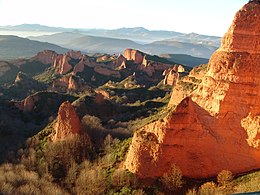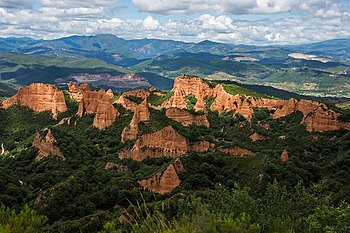| This article includes a list of general references, but it lacks sufficient corresponding inline citations. Please help to improve this article by introducing more precise citations. (January 2010) (Learn how and when to remove this message) |
| UNESCO World Heritage Site | |
|---|---|
 Panoramic view of Las Médulas Panoramic view of Las Médulas | |
| Location | Province of León, Castile and León, Spain |
| Includes |
|
| Criteria | Cultural: (i), (ii), (iii), (iv) |
| Reference | 803 |
| Inscription | 1997 (21st Session) |
| Area | 2,208.2 ha (5,457 acres) |
| Coordinates | 42°28′9.8″N 6°46′14.7″W / 42.469389°N 6.770750°W / 42.469389; -6.770750 |
  | |

Las Médulas (Spanish pronunciation: [las ˈmeðulas]) is a historic gold-mining site near the town of Ponferrada in the comarca of El Bierzo (province of León, Castile and León, Spain). It was the most important gold mine, as well as the largest open-pit gold mine in the entire Roman Empire. Las Médulas Cultural Landscape is listed by UNESCO as a World Heritage Site. Advanced aerial surveys conducted in 2014 using LIDAR have confirmed the wide extent of the Roman-era works.
The spectacular landscape of Las Médulas resulted from the ruina montium (wrecking of the mountains), a Roman mining technique described by Pliny the Elder in 77 AD. The technique employed was a type of hydraulic mining which involved undermining a mountain with large quantities of water. The water was supplied by interbasin transfer. At least seven long aqueducts tapped the streams of the La Cabrera district (where the rainfall in the mountains is relatively high) at a range of altitudes. The same aqueducts were used to wash the extensive alluvial gold deposits.
What became the Roman province of Hispania Tarraconensis was conquered in 25 BC by the emperor Augustus. Before the Roman conquest, the indigenous inhabitants obtained gold from alluvial deposits. Large-scale production did not begin until the second half of the 1st century AD.
Mining technique
Pliny the Elder, who was a procurator in the region in 74 AD, described a technique of hydraulic mining that may be based on direct observation at Las Médulas:
What happens is far beyond the work of giants. The mountains are bored with corridors and galleries made by lamplight with a duration that is used to measure the shifts. For months, the miners cannot see the sunlight and many of them die inside the tunnels. This type of mine has been given the name of ruina montium. The cracks made in the entrails of the stone are so dangerous that it would be easier to find purpurine or pearls at the bottom of the sea than make scars in the rock. How dangerous we have made the Earth!

Pliny also describes the methods used to wash the ores using smaller streams on riffle tables to enable the heavy gold particles to be collected. Detailed discussion of the methods of underground mining follows, once the alluvial placer deposits had been exhausted and the mother lode sought and discovered. Many such deep mines have been found in the mountains around Las Médulas. Mining would start with the building of aqueducts and tanks above the mineral veins, and a method called hushing used to expose the veins under the overburden.
The remains of such a system have been well studied at Dolaucothi Gold Mines, a smaller-scale site in South Wales. Opencast methods would be pursued by fire-setting, which involved building fires against the rock and quenching with water. The weakened rock could then be attacked mechanically and the debris swept away by waves of water. Only when all opencast work was uneconomical would the vein be pursued by tunneling and stoping.

Pliny also stated that 20,000 Roman pounds (6,560 kg) of gold were extracted each year. The exploitation, involving 60,000 free workers, brought 5,000,000 Roman pounds (1,640,000 kg) in 250 years.
Cultural landscape

Parts of the aqueducts are still well preserved in precipitous locations, including some rock-cut inscriptions.
Research on Las Médulas had been mainly carried out by Claude Domergue (1990). Systematic archaeological studies of the area, however, have been carried out since 1988 by the research group Social Structure and Territory-Landscape Archaeology of the Spanish Council for Scientific Research (CSIC). As a result, Las Médulas ceased to be only a gold mine with its techniques and became a cultural landscape in which all the implications of Roman mining were made apparent. The survey and excavations of pre-Roman and Roman settlements throughout the area allowed for new historical interpretations that greatly enriched the study of Roman mining.
A positive result of these systematic studies was the inclusion of Las Médulas as a World Heritage Site in 1997. Since then, the management of the Cultural Park has been monitored by the Las Médulas Foundation, which includes local, regional, and national stakeholders, both public and private. Currently, Las Médulas serves as an example of good research-management-society applied to heritage.
Environmental impact
The massive scale of mining at Las Médulas and other Roman sites had considerable environmental impact. Ice core data taken from Greenland suggest that mineral air pollution peaked during the Roman period in Spain. Levels of atmospheric lead from this period were not reached again until the Industrial Revolution some 1,700 years later.
The inclusion of Las Médulas as a World Heritage Site was controversial for similar reasons. The delegate from Thailand opposed the designation because he considered the site "a result of human destructive activities as well as harmful to the noble cause of environmental promotion and protection."
See also


- Air pollution
- Dolaucothi
- Gold mine
- Gold rush
- Hydraulic mining
- Naturalis Historia
- Pliny the Elder
- Roman technology
- Roman aqueducts
References
- El parque cultural | Paisaje cultural
- LIDAR surveys at Las Médulas.
- Cesare Rossi; Flavio Russo (26 August 2016). Ancient Engineers' Inventions: Precursors of the Present. Springer. pp. 185–192. ISBN 978-3-319-44476-5.
- Alfred Michael Hirt (25 March 2010). Imperial Mines and Quarries in the Roman World: Organizational Aspects 27 BC-AD 235. OUP Oxford. pp. 32–45. ISBN 978-0-19-957287-8.
- John F. Healy (1999). Pliny the Elder on Science and Technology. Oxford University Press. pp. 275–290. ISBN 978-0-19-814687-2.
- "Las Médulas".
- Pliny the Elder, Naturalis Historia, XXXIII, 70.
- Pliny the Elder, Naturalis Historia, XXXIII, 78.
- Domergue, C. (1990) Les mines de la Penínsule Ibérique dans l'antiquité romaine. Ècole Française de Rome, Rome.
- Sánchez-Palencia, F. J., ed., Las Médulas (León). Un paisaje cultural en la "Asturia Augustana" (León 2000).
- Orejas, A. and Sánchez-Palencia, F. J., Mines, Territorial Organization, and Social Structure in Roman Iberia: The Examples of Carthago Noua and the Peninsular Northwest, American Journal of Archaeology 106.4 (2002): 581-599
- Sánchez-Palencia, F. J. and A. Orejas (2006) "Mines et formes de colonisation des territoires en Hispanie occidentale". In L. Lévêque, M. Ruiz del Árbol, L. Pop and C. Bartels (eds.)
- McConnell, Joseph R.; Wilson, Andrew I.; Stohl, Andreas; Arienzo, Monica M.; Chellman, Nathan J.; Eckhardt, Sabine; Thompson, Elisabeth M.; Pollard, A. Mark; Steffensen, Jørgen Peder (2018-05-29). "Lead pollution recorded in Greenland ice indicates European emissions tracked plagues, wars, and imperial expansion during antiquity". Proceedings of the National Academy of Sciences. 115 (22): 5726–5731. Bibcode:2018PNAS..115.5726M. doi:10.1073/pnas.1721818115. ISSN 0027-8424. PMC 5984509. PMID 29760088.
- "21 COM VIII.C - Decision". UNESCO World Heritage Centre. Retrieved 2020-09-30.
Further reading
- Lewis, P. R. and G. D. B. Jones, Roman gold-mining in north-west Spain, Journal of Roman Studies 60 (1970): 169-85
- Jones, R. F. J. and Bird, D. G., Roman gold-mining in north-west Spain, II: Workings on the Rio Duerna, Journal of Roman Studies 62 (1972): 59–74.
- Domergue, C. and Hérail, G., Conditions de gisement et exploitation antique à Las Médulas (León, Espagne) in L'or dans l'antiquité: de la mine à l'objet, B. Cauuet, ed., Aquitania Supplement, 9 (Bordeaux 1999): 93–116.
- Journeys Through European Landscapes/Voyages dans les Paysages Européens. COST-ESF, Ponferrada: 101–104.
- Pipino g. "Lo sfruttamento dei terrazzi auriferi nella Gallia Cisalpina. Le aurifodine dell'Ovadese, del Canavese-Vercellese, del Biellese, del Ticino e dell'Adda". Museo Storico dell'Oro Italiano, Ovada 2015
External links
 Media related to Las Médulas at Wikimedia Commons
Media related to Las Médulas at Wikimedia Commons- Webpage of Fundación Las Médulas, with itineraries, virtual visit and practical information (in Spanish)
- UNESCO official website
- Photo gallery and explanation of the exploitation system (in Spanish)
- "Las Médulas, the Roman El Dorado". (in English) and (in Spanish) Article by the Leonese writer Julio Llamazares.
- Spanish site dedicated to Roman technology, especially aqueducts and mines
- Social Structure and Territory-Landscape Archaeology research group
- Action COST A27: Understanding pre-industrial rural and mining landscapes (LANDMARKS) European research project, a platform for scientific dissemination of Las Médulas
| Roman aqueducts | ||
|---|---|---|
| Croatia |  | |
| France | ||
| Germany | ||
| Italy | ||
| Jordan | ||
| Luxembourg | ||
| Spain | ||
| Tunisia | ||
| Turkey | ||
| United Kingdom | ||
- World Heritage Sites in Spain
- Roman towns and cities in Spain
- Gold mines in Spain
- Gold rushes
- Roman aqueducts outside Rome
- Roman sites in Spain
- Badlands
- Economic history of Spain
- El Bierzo
- Underground mines in Spain
- Geography of Castile and León
- Ponferrada
- Tourist attractions in Castile and León
- Archaeological sites in Castile and León
